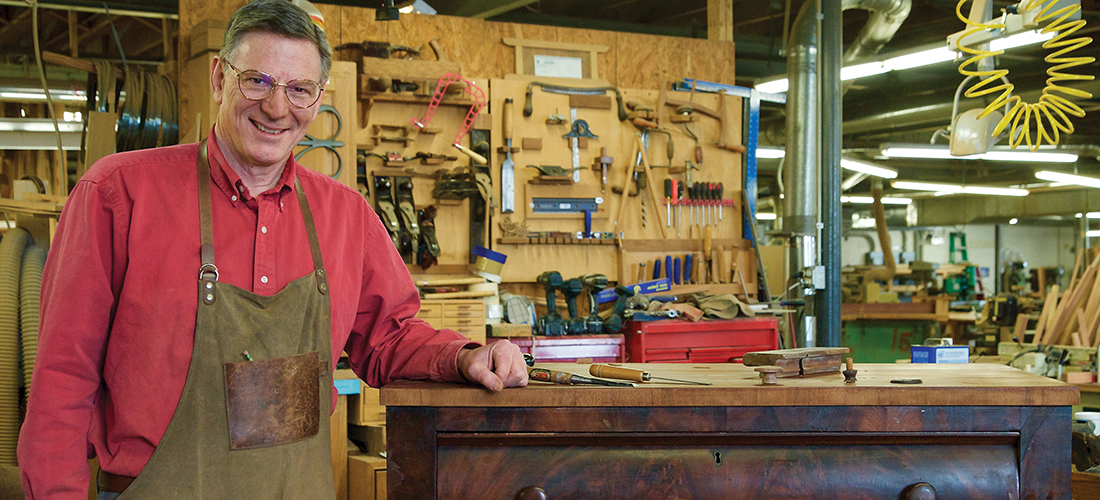
Saving the Day
Local craftsman Erich Thompson refreshes the work of
legendary cabinetmaker Thomas Day
By Ross Howell Jr.
Iím standing in the Patterson Street home of the Woodworker Group LLC, looking at a dark chest raised a few inches above the workshop floor.
To my untrained eye it’s unremarkable, really.
The rosewood veneer is dull with age. Some of the mahogany-finished walnut edges and carved details are badly chipped. There’s a gap in the top of the chest, and at least a dozen C-clamps are arranged around the edges to hold the veneer in place while glue sets.
Standing next to me is Erich Thompson, who sees my puzzlement and nods. He props his wire-rim glasses on his brow and rubs his eyes. The glasses drop back to his nose.
“Definitely the worse for wear,” he says. “Next step will be to replace the edging.”
Thompson is a fit, straight-shouldered man I met more than 10 years ago. My wife, Mary Leigh, had taken one of his woodworking courses years before and he’d come by to help us with some of the details on the Fisher Park bungalow we were renovating.
“I’m using hide glue,” Thompson says, made from, as the name implies, animal hides.“The same kind of glue Thomas Day would’ve used.”
On his business card Thompson describes himself as a “Woodworker.” The sign painted with his name outside his shop advertises “Handcrafted Furniture.”
Both accurate descriptions. But quietly modest, as is the man.
In fact, Thompson is to furniture what Horace is to the ode or Shakespeare to the sonnet.
A master. And there’s more to the story.
Formally he’s the Reverend Doctor Erich Thompson, a 1987 graduate of Union Presbyterian Seminary, Richmond, Virginia. He’s served congregations in Virginia and North Carolina, taking up woodworking as a hobby.
“The hobby got out of hand,” Thompson says with a wry smile.
A turning point came in 2004 when he attended a dedication ceremony for the sacred furniture — a baptismal bowl stand, an altar, a pulpit and a processional cross — he’d designed, made and donated to the Presbyterian Conference Center in Montreat.
“There must’ve been about 1,500 people in the crowd,” Thompson says. “I was very nervous, because my designs are sparse, you know? They’re not for everyone.”
When the hall echoed with the sound of applause, Thompson realized others shared his vision.
“A couple weeks later,” he says, “I got a call from Myers Park Presbyterian Church in Charlotte. They said they wanted a suite of pieces just like the ones in Montreat.”
In time, more churches began to contact him, asking him to create and produce designs for their sacred spaces.
His work has been commissioned for churches in Salisbury, North Wilkesboro, Clemmons, Asheville and Beth David Synagogue in Greensboro.
“A dream project was at Forest Lake Presbyterian in Columbia, South Carolina,” Thompson says. “They’re a high-risk, low-reward ministry. They’re not looking for security, but for challenge.
“The vaulted ceiling of the church is like an inverted boat,” he continues. “So I designed an altar that was the mirror of that image — the upright bow of the boat.”
These days Thompson is a busy man indeed. He has produced pieces for nearly 50 churches in 16 states. Right now he’s pondering projects in Virginia, D.C., Texas and Pennsylvania.
“I’m scheduled more than a year out,” he says. “But who wouldn’t make time for a Thomas Day piece?”
Thomas Day is a legendary figure for antiquers and students of American furniture. Born a free man of color in 1801 to a cabinetmaker in Dinwiddie County, Virginia, Day moved first to Hillsborough, North Carolina, to try his hand at cabinet making, and later to the town of Milton on the Dan River in Caswell County in the 1820s.
Despite racial prejudice and the legal restrictions — when Day married a freewoman living in Virginia, he had to petition the North Carolina General Assembly in order for her to join him in Milton, since an 1826 statute forbade free people of color from entering the state — he built a very successful business.
In 1847 Day purchased Union Tavern on Broad Street — now a historical museum, the Thomas Day House and Union Tavern. Day converted the structure into his personal residence and workshop. Fueled by the wealth that bright leaf tobacco brought to Caswell and Rockingham counties, Day’s shop, in 1850, would become the largest furniture-crafting operation in North Carolina — and the only one powered by steam — employing both black and white artisans.
Day not only designed and crafted furniture, but also made exquisitely curved staircase newels, windows, mantels, and other architectural features for nearby plantation houses in Virginia and North Carolina.
Day’s work is admired as much for its remarkable craftsmanship, as the cabinet maker’s unique adaptations of the popular designs of his time — described by Smithsonian Magazine as an “Exuberant Style” of ogee curves and curlicues that anticipated Art Nouveau.”
Day’s fortunes — and health — suffered during the severe economic downturn of 1857, and he passed away in 1861 at age 60, the year our nation fell into its most destructive and bloody internal conflict.
Many of Day’s pieces are in private homes and collections, but some 39 of his creations — including a magnificent what-not, a Gothic bed, a sofa, a Grecian style rocking chair, a chest of drawers with mirror, a side chair, a carved sewing stand and more — are in the collection of the North Carolina Museum of History in Raleigh. Another, a handsome dressing table with carved feet and a marble inlay is in the permanent collection at Winston-Salem’s Museum of Early Southern Decorative Arts (MESDA). “It’s impossible to underestimate the importance of Thomas Day not just to North Carolina, but to American decorative arts,” says Robert Leath, MESDA’s chief curator and vice-president of collections and research. Marveling at the size and modernization of Day’s manufacturing facility, Leath emphasizes that, “as a person of color living and working in the midst of a slave economy, Day’s professional accomplishments are nothing short of remarkable — and inspirational.”
In a nice twist to our story, Day designed and crafted the pews in Milton Presbyterian Church, built in 1837, purportedly so that he and his wife, Aquilla, could sit among the white worshippers, rather than in the balcony designated for slaves.
So just how did this old Day chest wind up in former Presbyterian minister, now master woodworker Thompson’s shop?
For that we can thank Greensboro native Sam Pass.
In 1995 Pass bought a run-down building on Gorrell Street known as the Magnolia House Motel. In its heyday during the Segregation era, the house had provided accommodations to African Americans closed off from white facilities.
And what a list of guests the motel had seen! Leaders like the Rev. Martin Luther King Jr. and his wife, Coretta Scott King. Philosopher and social critic Cornel West. Duke Ellington’s Band. Entertainers like the “Queen of R&B” Ruth Brown, Ray Charles, Lionel Hampton, James Brown, Ike and Tina Turner. Writer James Baldwin. Historian Carter G. Woodson. Baseball players like Satchel Paige and Jackie Robinson. World Heavyweight Boxing Champion Ezzard Charles.
“I remember one afternoon, I met soul singer Joe Tex on the front porch,” Pass says. “I was 13 or 14 years old. That made a real impression on me as a kid.”
Pass still works full-time as a life and safety officer at Duke University, but over the years he’s labored tirelessly to bring the Magnolia House back to its days of glory.
Pass gutted the place. He secured grants for furniture and architectural details. He received gifts of lumber, labor and stone for landscaping.
Now formally recognized as the Daniel D. DeButts House, informally as the Historic Magnolia House—“The House That Soul Built”—the place is now on the National Register of Historic Places.
“One day somebody came in and said, ‘That chest looks like a Thomas Day piece,’” Pass says.
So Pass got in touch with David Hoggard of Double Hung LLC and Pete Williams of Pete Williams Custom Woodworking — both located in the Patterson Street facility where Erich Thompson has his shop — since they had built the doors and windows for the renovation at Magnolia House.
“Well, they recommended Erich,” Pass continues.
So here we are, Thompson and I, standing in his shop. He shows me how to recognize the chest as a Day piece in the first place. He points out the elongated knuckles of the claw feet, the carved tobacco leaves — a Day touch replacing the acanthus leaves of traditional Greek Revival.
Thompson shows me the wooden screws of the drawer knobs, tooled by hand.
I ask him about the “restoration.” He politely says. “Day built his furniture to last for a hundred years, so you don’t ‘restore’ it,” Thompson says. “You ‘repair’ it.”
Thompson tells that craftsmen like Day left clues on how to repair what they’d created.
“I try to think the same way in the sacred pieces I build,” he says. “I leave clues, because I want my pieces to last for a hundred years, too.”
Thompson reflects for a moment, gazing at the chest.
“When I work on something like this,” he says quietly, “I feel like I’m shaking hands with a master.” OH
Ross Howell Jr. is compiling and editing the short stories, published and unpublished, he’s written over the years.





